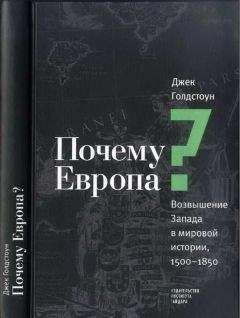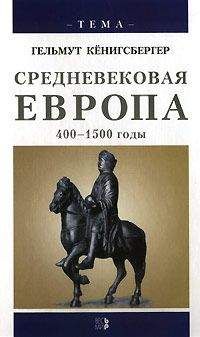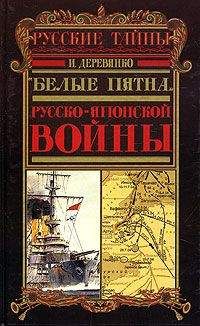Джек Голдстоун - Почему Европа? Возвышение Запада в мировой истории, 1500-1850

Помощь проекту
Почему Европа? Возвышение Запада в мировой истории, 1500-1850 читать книгу онлайн
12
ВВП скорректирован по паритету покупательной способности в постоянных ценах 2005 г.
13
Этот прогноз начинается с показателей ВВП по паритету покупательной способности за 2005 г., представленных в: World Bank International Comparison Program, Tables of Final Results (Washington, DC: International Bank for Reconstruction and Development, 2008), и завершается 2030 г. Темпы роста США в этом прогнозе составляют 3% в год, а Китая и Индии — 8%.
Ссылки
1
Маркс К., Энгельс Ф. Манифест Коммунистической партии // Маркс К., Энгельс Ф. Сочинения. 2-е изд. Т. 4. М.: Государственное издательство политической литературы, 1955. С. 419–459.
2
David Levine, At the Dawn of Modernity: Biology, Culture, and Material Life in Europe after the Tear 1000 (Berkeley: University of California Press, 2001); Alfred Crosby, The Measure of Reality: Quantification in Western Europe 1250–1600 (Cambridge: Cambridge University Press, 1997); Jan de Vries and Ad van der Woude, The First Modern Economy: Success, Failure, and Perseverance of the Dutch Economy 1500–1815 (Cambridge: Cambridge University Press, 1997)
3
John Hajnal, “Two Kinds of Pre-industrial Household Formation Sys tems”, Population and Development Review 8 (1992): 449–494; Wrigley and Schofield, Population History of England.
4
James Lee and Wang Feng, One Quarter of Humanity: Malthusian Mythology and Chinese Realities (Cambridge, MA: Harvard University Press, 1994.
5
David Hackett Fischer, The Great Wave: Price Revolutions and the Rhythm of History (New York: Oxford University Press, 1996).
6
Wrigley and Schofield, Population History of England, 528.
7
Chris Galley, The Demography of Early Modem Towns (Liverpool: Liverpool University Press, 1998), 5.
8
Robert Allen, “Agricultural Productivity and Rural Incomes in England and the Yangtze Delta c. 1620 — c. 1820”, Economic History Review (forthcoming, 2008); Jack A. Goldstone, “Feeding the People, Starving the State: China’s Agricultural Revolution of the I7th/18th Centuries”, (paper presented to the Global Economic History Network, Irvine, California, 2003); Kenneth Pomeranz, The Great Divergence (Princeton, NJ: Princeton University Press, 2000).
9
Подробнее о Чжэн Хэ см.: Louise Levathes, When China Ruled the Seas (New York Oxford University Press, 1994).
10
Mark Overton, Agricultural Revolution in England: The Transformation of the Agrarian Economy 1500–1850 (Cambridge: Cambridge University Press, 1996), 82.
11
Mark Elvin, The Pattern of the Chinese Past (Stanford, CA: Stanford University Press, 1973).
12
S. N. Eisenstadt, The Origins and Diversity of Axial Age Civilizations (Albany, NY: SUNY Press, 1986).
13
Randall Collins, “An Asian Route to Capitalism: Religious Economy and the Origins of Self-Transforming Growth in Japan”, American Sociological Review 62, no. 6 (1997): 843–865.
14
См. «Книгу полезной информации о принципах и правилах навигации», написанную в 1490 г.: http://www.saudiaramcoworld.com/ issue/200504/the.navigator.ahmad.ibn.majid.htm.
15
John М. Hobson, The Eastern Origins of Western Civilization (Cambridge: Cambridge University Press, 2004), 149; Sushi! Chaudhury, “The Inflow of Silver to Bengal in Global Perspective, c. 1650–1757”, in Global Connections and Monetary History, 1470–1800, ed. Dennis O. Flynn, Arturo Giraldez, and Richard von Glahn (Aldershot, UK: Ashgate Publishing, 2003), 167.
16
Massimo Livi-Bacci, A Concise History of World Population (Oxford, UK: Blackwell, 1992), 31.
17
Об Англии (включая Уэльс): E.A. Wrigley and Roger Schofield, Population History of England, 1341–1871: A Reconstruction (Cambridge: Cambridge University Press, 1,989), 529. О России: Livi-Bacci, ibid. О Китае: James Lee and Wang Keng, One Quarter of Humanity: Malthusian Mythology and Chinese Realities (Cambridge, MA: Harvard University Press, 1999), 28.
18
Источники: Massimo Livi-Bacci, History of World Population (Oxford, UK: Blackwell, 1992); James Lee and Wang Feng, One Quarter of Humanity: Malthusian Mythology and Chinese Realities (Cambridge, MA: Harvard University Press, 1999), p-54; Грегори Кларк, Прощай, нищета! Краткая экономическая история мира (М.: Издательство Института Гайдара, 2012).
19
Nikola Koepke and Joerg Baten, “The Biological Standard of Living in Europe during the Last Two Millennia”, European Review of Economic History 9 (2005): 61–95.
20
Источник: Robert С. Allen, “The Great Divergence in European Wages and Prices from the Middle Ages to the First World War”, Exploration in Economic History 38 (2001): 428.
21
Источник: Robert С.Allen, “Real Wages in Europe and Asia: A First Look at the Long-Term Patterns”, in Living Standards in the Past: New Perspectives on Well-Being in Asia and Europe, ed. Robert G. Allen, Tommy Bengtsson, and Martin Dribe (Oxford, UK: Oxford University Press, 2005), p. 122.
22
Источник: Tertius Chandler, Four Thousand Tears of Urban Growth: An Historical Census (Lewiston, NY: Edwin Mellon Press, 1987).
23
Источник: Robert С. Allen, “Agricultural Productivity and Rural Incomes in England and the Yangtze Delta, c. 1620-c. 1820”, Economic History Review, 2009, vol. 62,
24
Gregory Clark, “Farm Wages and Living Standards in the Industrial Revolution: England, 1670–1869”, The Economic History Review 54 (2001): 496.
25
Peter Lorge, War Politics and Society in Early Modem China, 900-1795 (London: Routledge, 2005), p. 103.
26
Источник: Li Chen and Ugurlu Soylu, “Innovations in the Chinese History of Science: Compiled from Joseph Needham’s Science and Civilization in China”, in Political Competition, Innovation and Growth in the History of Asian Civilizations, edited by Peter Bernholz and Roland Vaubel (Cheltenham, UK: Edward Elgar, 2004), p. 92.
27
Хлопок: потреблено тыс. метр. т необработанного хлопка-сырца. Из: В. R. Milchcll, European Historical Statistics 1750-1970 (Columbia University Press, 1978), pp. 251–254.
28
Уголь: добыто млн. метр. т. Из: http://www.historylearningsite.co.uk/coal.htm.
29
Первичный чугун: произведено тыс. т. Данные на период 1700–1850 из: P.Riden “The output of the British iron industry before 1870” Economic History Review 30,1997, pp. 443, 448, 455; на 1900 г. см.: В. R. Mitchcll, European Historical Statistics 1750–1970 (New York; Columbia University Press, 1978), p. 218.
30
Пароходы: тыс. т водоизм. Цит. no: Simon Ville, “Transport” in R. Floud and P. Jonshon, Cambridge Economic History of Modem Britain, 1700–1860 (Cambridge, UK: Cambridge University Press, 2004), p.303 [1820J.
31
Железные дороги: km. Цит. no: Simon Ville, “Transport”, in R. Floud and P.Jonshon, Cambridge Economic History of Modern Britain, 1700–1860 (Cambridge, UK: Cambridge University Press, 2004), p.305 [1830].
32
Паровые двигатели и водоподъемные колеса: тыс. л.с. (в основном в горной промышленности и производстве). Цит. но: Alessandro Nuvo- lari, The Making of Steam Power Technology (Eindhoven, Netherlands: Eindhoven University Press, 2004), p. 8 [за период 1830–1870].
33
Шерстяные изделия: потреблено тыс. метр. м шерсти-сырца. Цит. по: В. R. Mitchell, European Historical Statistics 1750–1970 (New York: Columbia University Press, 1978), pp. 260–262 [1775, 1810].
34
Льняные изделия: потреблено тыс. метр, т льна и пеньки. Цит. по: В. R. Mitchell, European Historical Statistics 1750–1970 (New York: Columbia University Press, 1978), pp. 268–269 [1775, 1810].
35
Население: млн. жителей в Англии и Уэльсе. Цит. по: E.A.Wrigley and R. S. Schofield, The Population History of England, 1541–1871 (Cambridge, MA; Harvard University Press, 1981), pp. 528–529.
36
Nathan Rosenberg, Inside the Black Box: Technology and Economics (Cambridge, UK: Cambridge University Press, 15)82), 59–60.
37
Abbott Pavson Usher, “The Industrialization of Modern Britain”, Technology and Culture 1 (i960): 110.
38
William N. Parker, Europe, America, and the Wider World, Essays on the Economic History of Western Capitalism (Cambridge, UK: Cambridge University Press, 1984), 33.
39
Ian Inkster, “Technology as the Cause of the Industrial Revolution, Some Comments”, Journal of European Economic History 12 (1983): 656.
40
Е. A. Wrigley, Continuity, Chance, and Change (Cambridge, UK: Cambridge University Press, 1.988).
41
Joel Mokyr, Ihe Gifts of Athena: Historical Origins of the Knowledge Economy (Princeton, NJ: Princeton University Press, 2002), 29.
42
JohnJ. O’Conner and Edmund F. Robertson, “Arab Mathematics: Forgotten Brilliance?” The MacTutor History of Mathematics Archive (School of Mathematics and Statistics, University of St. Andrews, Scotland: 1999), http://www-history.mcs.st-andrews.ac.uk/Historics/Arabic_mat hematics.html.
43
Ibid.
44
Vaclav Smil, Energy in World History (Boulder, CO: Westview, 1994), 186–187.
45
Jonathan Spence, The Search for Modern China (New York: W. W. Norton, 1990), 158.
46
World Bank Development Indicators on-line, http://mutex.gmu.edu: 3.9 65/ex t/DDPQQ/member.do?method_getMembers&userid_i&queryld_6.

























